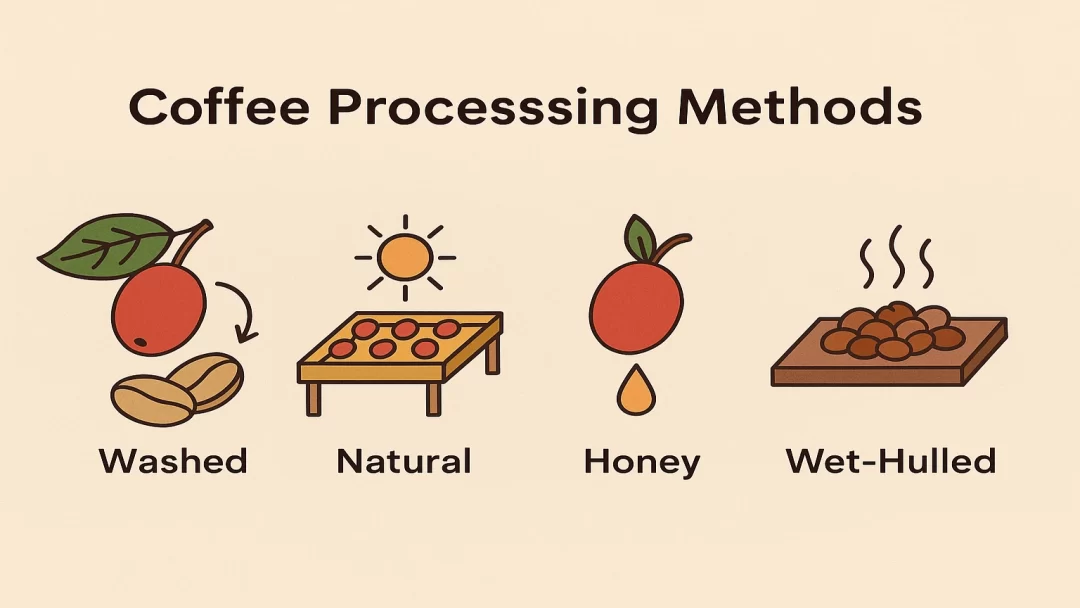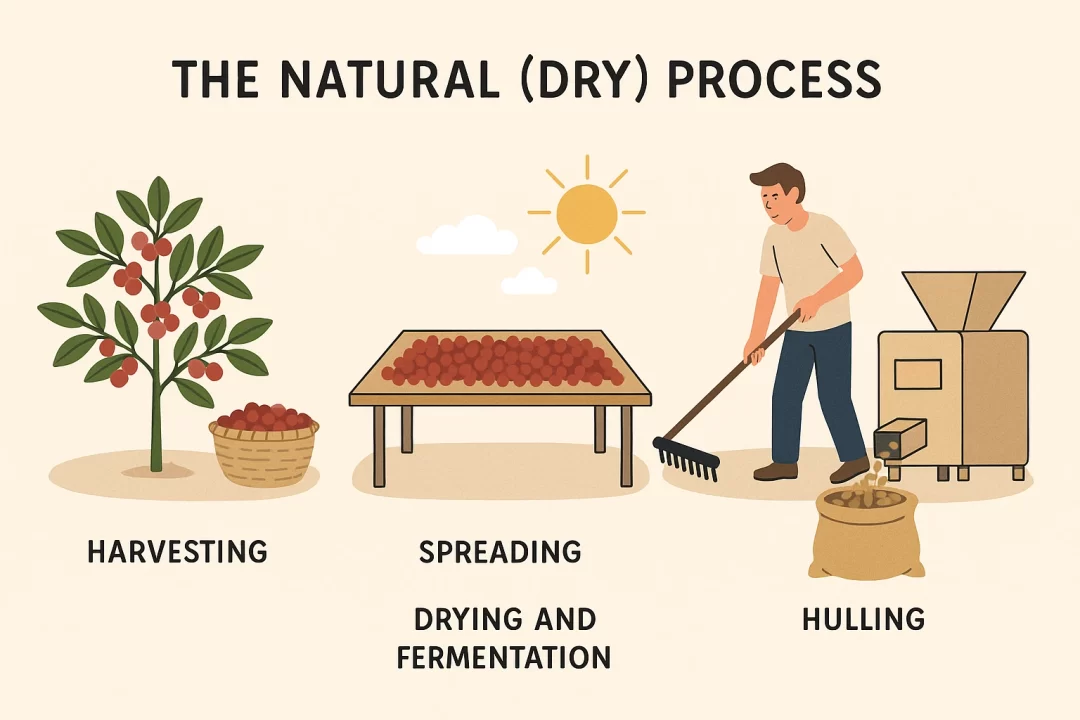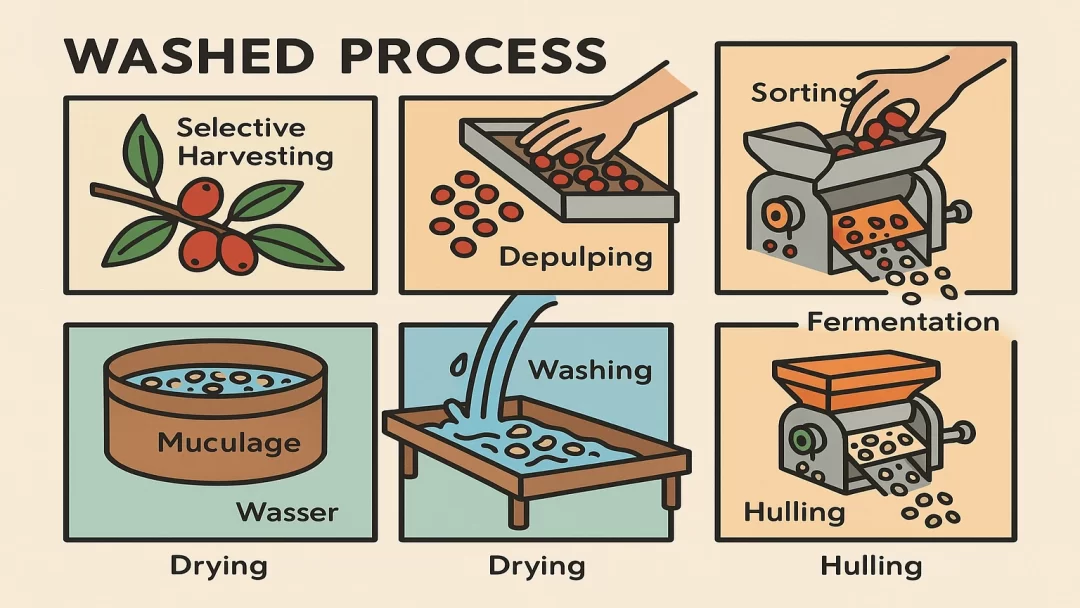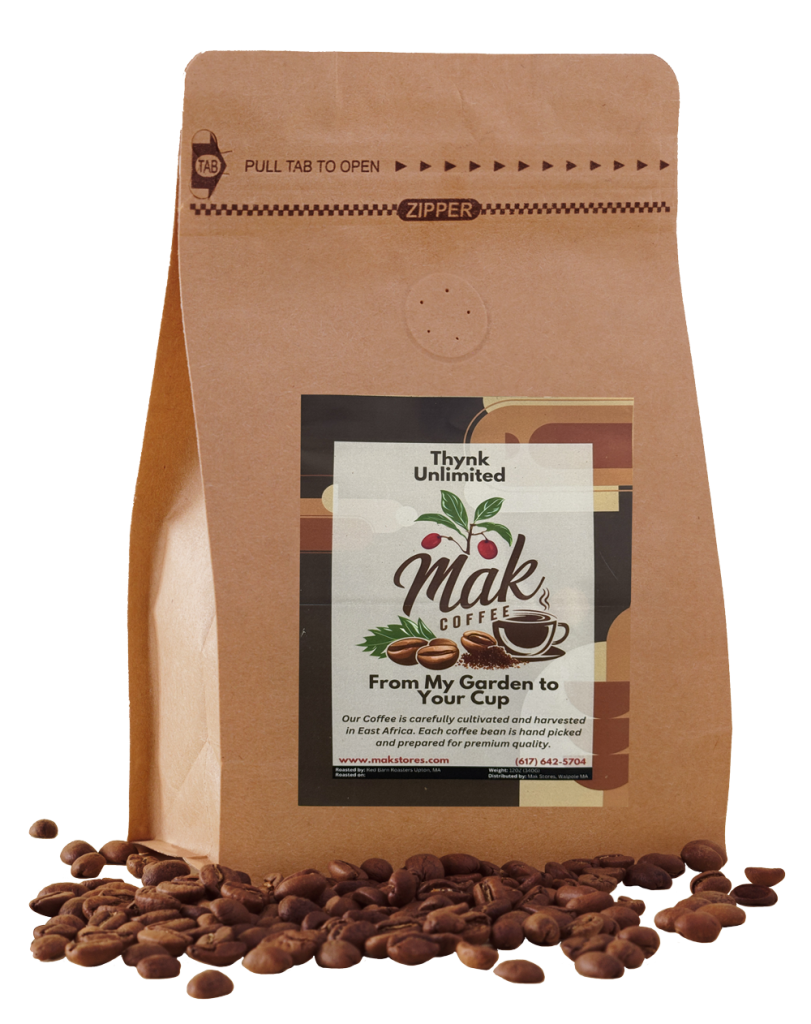
The journey from a coffee cherry to your daily cup involves a crucial stage known as coffee processing. While harvesting ripe, high-quality cherries and perfecting the roast are essential steps, it’s the processing method that often has the biggest impact on the final flavor in your cup.
Coffee processing involves removing the coffee seed, what eventually becomes the bean, from the surrounding layers called the pulp, sticky mucilage, and parchment. How this is done greatly affects the coffee’s sweetness, body, and acidity.
There are four main coffee processing methods, each shaping the flavor in its own way:
- Natural (Dry) Process
- Washed (Wet) Process
- Honey Process
- Wet-Hulled Process
Understanding these methods is key to appreciating the wide variety of flavor profiles found in specialty coffees. Whether you’re tasting fruity, clean, or earthy notes, the processing method plays a big part in that experience.
What Exactly is Coffee Processing?
Think of coffee processing as the steps taken to separate the coffee bean (the seed) from the coffee cherry (the fruit). Just like any fruit with a pit, a coffee cherry has a seed, the fleshy pulp around it, a sticky layer called mucilage hugging the seed, and an outer skin. There are different ways to get that seed out, and these methods have a real impact on the seed’s flavor as it’s roasted and becomes the coffee bean you know and love – that flavor sticks around to your final brewed cup.
There are four main ways to process coffee, and each one tweaks the sweetness, body (how it feels in your mouth), and acidity (that bright, zesty feeling) of your brewed coffee. These methods are called natural process, washed process, wet hulled, and honey processed.
1. The Natural (Dry) Process
Natural processed coffee, also known as dry processed, is a classic way of doing things, and it’s still pretty common today. It started in Ethiopia and involves drying the entire freshly picked coffee cherry with the bean still inside. Here’s how it works:
Steps in Natural Processing:
- Harvesting: Ripe coffee cherries are picked from the coffee trees.
- Spreading: Coffee farmers spread all the cherries out in a single layer on drying beds in the sun – these can be concrete patios or raised drying tables.
- Drying and Fermentation (3-6 weeks): The cherries are left to dry in the sun. During this time, the sugars and the sticky mucilage layer naturally cause the coffee to ferment.
- Turning and Raking: Farmers regularly rake and turn the cherries multiple times a day. This ensures even drying and helps prevent mold growth.
- Moisture Monitoring: The moisture content of the cherries is carefully monitored throughout the drying process.
- Hulling: Once the cherries are fully dry and reach the desired moisture level, a machine called a huller separates the dried pulp (skin and fruit) from the coffee seed (bean).
- Sorting and Grading: The green coffee beans are then sorted by size and density, and visually inspected for any defects.

Why Natural Coffees Taste So Unique?
Natural coffees often result in a heavier-bodied cup with deeper, more complex tasting notes because of the extra time the bean spends developing flavors inside the cherry.
This fermentation process is unique because the seeds dry with the whole fruit intact. Natural processed coffees can be a bit tricky to get consistently because the fermentation can vary.
Hand-raking can mean some cherries get more sun and air than others, and they can get moldy if not handled carefully.
But when it’s done right, these coffees can also be some of the sweetest and most interesting you’ll ever taste, often described as juicy, syrupy, and worth the extra effort.
Flavor Profile of Natural Coffee:
Natural processed coffees are known for their intense and often fruit-forward flavors, along with:
- Lower Acidity: A smoother and less tangy profile.
- Fuller Body: A heavier and more syrupy mouthfeel.
- Pronounced Sweetness: Often reminiscent of dried fruits like berries, raisins, or dates.
- Unique Aromas: Can range from tropical fruit and wine-like notes to chocolate and spice.
MAK Coffee offers natural processed coffees for those seeking a bolder and more unconventional flavor experience
2. The Washed (Wet) Process
Washed Process: Clean and Crisp Flavors
Washed processed coffees, also called wet processed, use a different approach to reveal the bean. Here are the steps involved:
Steps in Washed Processing:
- Selective Harvesting: Only perfectly ripe coffee cherries are picked.
- Sorting: The ripe cherries are sorted, often by density, to ensure consistent sweetness.
- Depulping: Machines called depulpers remove the outer skin and most of the fruit pulp from the cherries.
- Fermentation: The remaining mucilage-covered seeds are placed in tanks of water to ferment. This natural process helps break down the sticky mucilage.
- Washing: Once fermentation is complete, the beans are thoroughly washed with clean water to remove all remaining mucilage and fruit residue.
- Drying: The clean, parchment-covered beans are then spread out on drying beds in the sun or are used in mechanical dryers to reduce their moisture content.
- Hulling: After drying, the parchment layer is removed from the green coffee beans.
- Sorting and Grading: Finally, the beans are sorted by size and density and visually inspected for defects.

The Trade-offs: Efficiency vs. Environment
The washed method, while quick and efficient, can use a lot of water, which can be tough on the environment. Those washing stations also create a lot of solid waste and need a good amount of equipment, technology, and energy to run, which can be costly. However, if the water in these tanks can be cleaned and reused (usually by adjusting its pH level), then this processing method can be more environmentally friendly.
Flavor Profile of Washed Coffee:
Washed coffees are celebrated for their clarity of flavor, allowing the inherent characteristics of the bean’s origin to shine through. You can often expect:
- Bright Acidity: A lively and refreshing tanginess.
- Clean Body: A smooth and well-defined mouthfeel.
- Subtle Sweetness: Often delicate and nuanced.
- Complex Aromas: Floral, citrusy, or herbal notes are common.
MAK Coffee often features washed coffees to highlight the unique terroir of specific regions, allowing you to truly taste the essence of the bean.
3. The Honey Process
The honey process is a fascinating hybrid method that falls between washed and natural processing. It involves removing the outer skin and some of the pulp (mucilage), but then drying the bean with a varying amount of this sticky, sugary mucilage still attached. The amount of mucilage left on the bean and the drying time influence the final flavor. There are different variations of the honey process, often categorized by the amount of mucilage retained (white, yellow, red, black honey).
Honey processed coffee offers a unique flavor profile by combining elements of both natural and washed processing. It’s a less common and more intricate method, but the results can be truly special.
Steps in Honey Processing:
- Selective Harvesting: Only ripe coffee cherries are picked.
- Depulping: A depulper machine removes the outer skin and some of the pulp from the cherries, similar to the washed process.
- Mucilage Retention: Unlike the washed process, the beans are not washed to remove the sticky mucilage. Instead, a specific percentage of the mucilage is left coating the beans. The amount retained significantly impacts the final flavor.
- Drying: The mucilage-coated beans are then spread out on raised drying beds in the sun.
- Careful Monitoring and Turning: The beans are meticulously monitored and turned regularly to ensure even drying and prevent mold growth. The mucilage is sticky and can lead to uneven drying if not managed properly.
- Drying Duration: The drying time varies depending on the amount of mucilage left on the beans and the desired flavor profile. Different levels of mucilage retention are often referred to as White Honey (least mucilage), Yellow Honey, Red Honey, and Black Honey (most mucilage), each requiring different drying times and producing distinct characteristics.
- Hulling: Once the beans reach the optimal moisture level, the dried mucilage layer and the parchment are removed.
- Sorting and Grading: The final green coffee beans are sorted and graded based on size and quality.
Flavor Profile of Honey Coffee:
Honey processed coffees offer a diverse range of flavors, often exhibiting characteristics of both washed and natural coffees:
- Balanced Acidity: Typically lower than washed but brighter than natural.
- Medium to Full Body: A pleasant and often syrupy mouthfeel.
- Distinct Sweetness: Often with notes of honey, caramel, or brown sugar.
- Fruity Undertones: Depending on the amount of mucilage and drying time, it can exhibit notes of stone fruit or berries.
MAK Coffee appreciates the complexity and sweetness that honey processing can impart, often featuring these unique coffees in our selection.
4. The Wet-Hulled (Giling Basah) Process: Earthy and Bold
The wet-hulled process, also known as Giling Basah, is a unique method primarily practiced in Indonesia, particularly in regions like Sumatra. It involves a distinctive double-hulling process that contributes to the coffee’s characteristic, earthy, and often bold flavor profile.
- Pulping: The outer skin is removed mechanically.
- Partial Drying and Hulling (Wet Hulling): The beans, still with a high moisture content (around 30-50%) and their parchment layer, are hulled, removing the parchment. This exposes the soft, green bean.
- Drying (Second Drying): The naked green beans are then dried a second time on patios or raised beds until the moisture content reaches the standard 10-12%.
Flavor Profile of Wet-Hulled Coffee:
Wet-hulled coffees are known for their distinctive and often intense flavor characteristics:
- Low Acidity: A smooth and less tangy profile.
- Heavy Body: A full and often syrupy mouthfeel.
- Earthy Notes: Often described as having hints of spice, tobacco, or forest floor.
- Bold Flavors: Can range from chocolate and cedar to tropical fruit in some cases.
MAK Coffee recognizes the unique character of wet-hulled coffees, often featuring Sumatran varieties that showcase these distinctive, earthy, and bold notes.
Understanding Processing Preferences to Choose Your Coffee
Understanding these coffee processing methods can empower you to explore a wider range of flavors and find coffees that perfectly match your palate.
- If you prefer a clean, bright, and nuanced cup, look for washed processed coffees.
- For a bold, sweet, and fruit-forward experience, naturally processed coffees might be your ideal choice.
- If you enjoy a balance of sweetness and acidity with unique fruity undertones, explore the diverse world of honey-processed coffees.
- For a distinctly earthy, bold, and often heavy-bodied brew, try wet-hulled processed coffees.
At MAK Coffee, we carefully select and roast beans processed using various methods to bring you a diverse and exciting coffee experience. We believe that understanding the journey from cherry to cup enhances your appreciation for the incredible flavors that coffee has to offer. Explore our selection and embark on a delicious journey of discovery!
Pay Attention to the Label!
Next time you’re buying a bag of beans, take a look at the label for the processing method – it’s usually listed there. You might be surprised to learn how much these different methods can change and enhance the taste of your final brew! Trying coffees processed in different ways is a great way to explore the amazing variety that coffee has to offer.
Take Away
So, the next time you reach for your favorite brew, take a moment to appreciate the journey from cherry to cup. The processing method is a key part of that story—and it plays a big role in shaping the flavors you enjoy.
At Mak Coffee, we highlight these unique processing methods on every product page to help you explore new taste profiles with confidence. Whether you’re sipping our fruity Kenya AA or the rich, earthy Sumatra Mandheling, there’s always something new to discover.
Happy brewing! And if you’re hungry for more coffee knowledge, check out our other blog posts.

